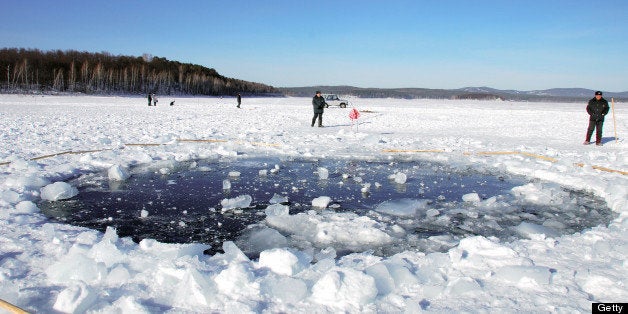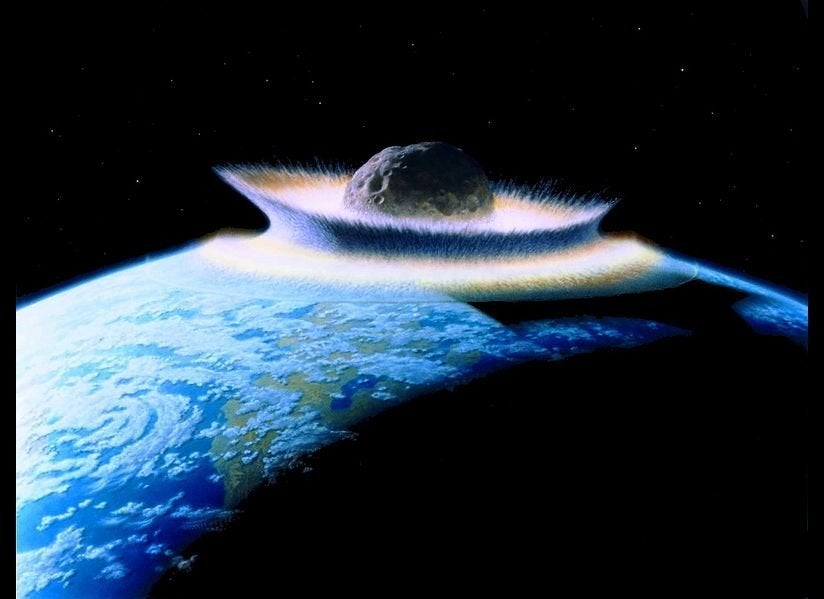
The house-sized rock that exploded spectacularly in the skies near Chelyabinsk, Russia, in February may have been a member of a gang of asteroids that still poses a threat to Earth, a new study says. The evidence is circumstantial, but future observations could help to settle the question.
On 15 February, an 11,000-ton space rock slammed into the atmosphere above Russia, producing the most powerful impact since the Tunguska explosion in 1908 — which may also have been caused by an asteroid — and generating a shock wave that damaged buildings and injured more than 1,000 people. The 18-metre-wide object could not be seen as it approached the planet because it was obscured by the Sun's glare, but observations made while it was in the atmosphere have enabled several groups of researchers to estimate its orbit.
However, the estimates varied so much that there was no clear orbit that researchers could use to hunt for sibling asteroids on a similar path, say Carlos and Raúl de la Fuente Marcos, orbital dynamicist brothers at the Complutense University of Madrid.
They decided to tackle the problem with brute computational force, running simulations of billions of possible orbits to find the ones most likely to have led to a collision. They then used the average of the ten best orbits to search a NASA asteroid catalogue for known objects on similar paths. They found about 20, ranging in size from 5 to 200 metres across, they report in an article to be published in Monthly Notices of the Royal Astronomical Society: Letters.
Broken family
The researchers propose that these rocks are pieces of a rubbly asteroid that came apart some time in the past 40,000 years. The break-up may have been triggered by stresses from temperature swings as the parent asteroid looped out past Mars and then back towards Venus on its travels around the Sun, says Carlos de la Fuente Marcos.
The rocky fragments could one day follow their planet-pummelling sibling to Earth, he says. "More objects with the same orbital signature may encounter our planet in the future."
But don't panic just yet. The researchers acknowledge that the gravitational pull of the planets might have affected the path of each asteroid in a slightly different way, and that those differences would tend to grow over time. So even if the orbits of these objects were very similar at first, they could change completely.
The authors also admit that the orbits of the asteroids in the proposed group are not known with certainty, meaning that the objects may not be related to each other or to the Chelyabinsk meteor.
The best sibling candidate, for instance, is a 200-metre-wide asteroid known as 2011 EO40, whose orbit was calculated from observations taken over just 34 days. That is too short a time to be able to pinpoint its position in the future, says Jon Giorgini, a senior analyst in the Solar System Dynamics Group at NASA's Jet Propulsion Laboratory in Pasadena, California. For that, researchers would need observations taken over the asteroid's two-year orbit, he says.
David Nesvorny, who studies asteroids at the Southwest Research Institute in Boulder, Colorado, also urges caution in drawing this particular family tree. "I think that the resemblance of orbits is coincidental," he says. "It is not obvious to me why [the Chelyabinsk meteor] cannot be a fragment that was produced by a collision in the main asteroid belt, and evolved to its impact orbit by a few planetary encounters.”
The only way to prove a connection would be to collect samples from one of the proposed family members and compare them with meteorites collected from the Chelyabinsk region, says Carlos de la Fuente Marcos. However, a cheaper way to find out whether the suspected siblings have at least a passing resemblance could be to measure their composition from their light spectra.
This story originally appeared in Nature News.
